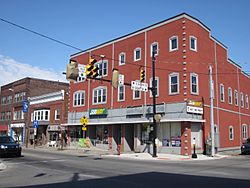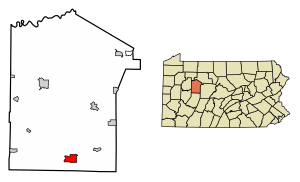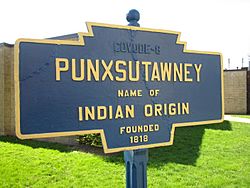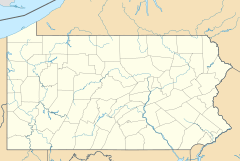Punxsutawney, Pennsylvania facts for kids
Quick facts for kids
Punxsutawney, Pennsylvania
Punkwsutènay (Unami)
|
||
|---|---|---|
|
Borough
|
||

Downtown Punxsutawney, Pennsylvania
|
||
|
||
| Nickname(s):
"Weather Capital of the World," "Punxsy"
|
||

Location of Punxsutawney in Jefferson County, Pennsylvania.
|
||
| Country | United States | |
| State | Pennsylvania | |
| County | Jefferson | |
| Settled | 1816 | |
| Incorporated | 1850 | |
| Government | ||
| • Type | Borough Council | |
| Area | ||
| • Total | 3.43 sq mi (8.88 km2) | |
| • Land | 3.37 sq mi (8.72 km2) | |
| • Water | 0.06 sq mi (0.17 km2) | |
| Elevation | 1,230 ft (370 m) | |
| Population
(2020)
|
||
| • Total | 5,769 | |
| • Density | 1,713.90/sq mi (661.71/km2) | |
| Time zone | UTC-5 (Eastern (EST)) | |
| • Summer (DST) | UTC-4 (EDT) | |
| Zip Code |
15767
|
|
| Area code(s) | 814 |
|
| FIPS code | 42-62920 | |
Punxsutawney (pronounced PUNK-suh-TAW-nee) is a small town, called a borough, in Jefferson County, Pennsylvania, United States. This town is famous for its yearly Groundhog Day celebration on February 2nd. Thousands of people and news reporters from all over the world come to see Punxsutawney Phil, a groundhog who is said to predict the weather. The place where Phil makes his prediction, called Gobbler's Knob, is actually in a nearby area called Young Township.
Punxsutawney is about 84 miles (135 km) northeast of Pittsburgh. It was officially made a borough in 1850. In 2010, about 5,962 people lived there, making it the biggest town in Jefferson County.
Contents
History of Punxsutawney
Early Settlements and the Name's Origin
Long ago, Shawnee and Lenape Native American villages were located where Punxsutawney is now, near Mahoning Creek. The first non-Native American settlers arrived in 1772. Reverend John Ettwein, a missionary, came with 241 Christianized Lenape people. However, tiny biting insects, like gnats and sandflies, made life very difficult for the early settlers and their animals. These insects were so bad that Ettwein could not create a lasting settlement, and the Native people eventually left the area because of them.
The Native Americans called these insects ponkies, which meant "living dust and ashes." They called their village Ponkis Utenink, meaning "land of the ponkies." This is how the name Punxsutawney came to be. One story says that an old sorcerer was killed and his ashes turned into these tiny biting insects. Another idea is that the insect bites felt like burns from sparks or hot ashes.
The name Punxsutawney comes from the Unami dialect of the Lenape language, Punkwsutènay. This means "town of the sandflies" or "town of the mosquitoes." The Native American tribes, including the Shawnee and Delaware, moved to Ohio after the American Revolution.
Growth and Development of the Borough
The Pennsylvania Department of Transportation says Punxsutawney was founded in 1818. By 1840, it was a small village with about 15 to 20 homes. More settlers came to the area for lumbering (cutting down trees) and coal mining. They eventually drained the swampy areas, which helped get rid of the insects. The Borough of Punxsutawney was officially formed in 1850, and at that time, 256 people lived there.
In 1907, Punxsutawney joined with another nearby town, Claysville, to become "Greater Punxsutawney." This made the population grow to 9,058 people by 1910. High-quality soft coal was mined in the area. After 1850, factories started to become more important than mining. These included places that made bricks, glass, leather, and metal goods. There were also shops for machines, and mills for wood, flour, and silk. By the 1930s, many of these factories were gone. The town then relied more on the Baltimore & Ohio Railroad repair shops, a meat packing plant, and the remaining coal mines.
The town's population changed over the years:
- 1900: 6,746 people (before joining Claysville)
- 1910: 9,058 people
- 1920: 10,311 people
- 1930: 9,266 people
- 1940: 9,482 people
- 1950: 8,969 people
- 2010: 5,962 people
Punxsutawney Phil and Famous Places
The famous groundhog Punxsutawney Phil lives near Punxsutawney in Young Township. He is known for predicting the weather every year on Groundhog Day, February 2nd. This event was even the main idea for the 1993 movie Groundhog Day. However, almost all of the movie was filmed in Woodstock, Illinois, not Punxsutawney.
Several buildings in Punxsutawney are listed on the National Register of Historic Places. These include the T. M. Kurtz House, the Jefferson Theater, the Christian Miller House, and the United States Post Office-Punxsutawney.
Geography and Climate
Punxsutawney is located at coordinates 40°56′44″N 78°58′31″W / 40.94556°N 78.97528°W. It is about 80 miles (129 km) northeast of Pittsburgh. The town covers an area of about 3.4 square miles (8.8 km²). A small river called Mahoning Creek flows through the town. Punxsutawney is surrounded by Young Township to the north, west, and south, and by Bell Township to the east.
| Climate data for Punxsutawney, Pennsylvania | |||||||||||||
|---|---|---|---|---|---|---|---|---|---|---|---|---|---|
| Month | Jan | Feb | Mar | Apr | May | Jun | Jul | Aug | Sep | Oct | Nov | Dec | Year |
| Record high °F (°C) | 70 (21) |
71 (22) |
79 (26) |
89 (32) |
92 (33) |
99 (37) |
101 (38) |
100 (38) |
99 (37) |
90 (32) |
81 (27) |
64 (18) |
101 (38) |
| Mean daily maximum °F (°C) | 33.1 (0.6) |
36.7 (2.6) |
45.9 (7.7) |
59.6 (15.3) |
69.2 (20.7) |
77.3 (25.2) |
80.7 (27.1) |
79.6 (26.4) |
72.2 (22.3) |
60.8 (16.0) |
49.1 (9.5) |
36.9 (2.7) |
58.4 (14.7) |
| Mean daily minimum °F (°C) | 16.2 (−8.8) |
17.8 (−7.9) |
24.1 (−4.4) |
34.0 (1.1) |
43.8 (6.6) |
52.7 (11.5) |
57.1 (13.9) |
55.7 (13.2) |
48.4 (9.1) |
37.5 (3.1) |
30.5 (−0.8) |
21.4 (−5.9) |
36.6 (2.6) |
| Record low °F (°C) | −27 (−33) |
−23 (−31) |
−15 (−26) |
11 (−12) |
22 (−6) |
28 (−2) |
31 (−1) |
31 (−1) |
18 (−8) |
14 (−10) |
0 (−18) |
−26 (−32) |
−27 (−33) |
| Average precipitation inches (mm) | 3.18 (81) |
2.79 (71) |
3.70 (94) |
3.63 (92) |
4.13 (105) |
5.03 (128) |
4.58 (116) |
4.10 (104) |
4.14 (105) |
3.05 (77) |
3.65 (93) |
3.44 (87) |
45.42 (1,154) |
| Average snowfall inches (cm) | 14.2 (36) |
9.9 (25) |
9.6 (24) |
1.9 (4.8) |
0 (0) |
0 (0) |
0 (0) |
0 (0) |
0 (0) |
0.1 (0.25) |
2.4 (6.1) |
11.3 (29) |
49.4 (125) |
People of Punxsutawney
| Historical population | |||
|---|---|---|---|
| Census | Pop. | %± | |
| 1850 | 256 | — | |
| 1860 | 415 | 62.1% | |
| 1870 | 553 | 33.3% | |
| 1880 | 674 | 21.9% | |
| 1890 | 2,792 | 314.2% | |
| 1900 | 4,375 | 56.7% | |
| 1910 | 9,058 | 107.0% | |
| 1920 | 10,311 | 13.8% | |
| 1930 | 9,266 | −10.1% | |
| 1940 | 9,482 | 2.3% | |
| 1950 | 8,969 | −5.4% | |
| 1960 | 8,805 | −1.8% | |
| 1970 | 7,792 | −11.5% | |
| 1980 | 7,479 | −4.0% | |
| 1990 | 6,782 | −9.3% | |
| 2000 | 6,271 | −7.5% | |
| 2010 | 5,962 | −4.9% | |
| 2020 | 5,769 | −3.2% | |
| Sources: | |||
In 2010, there were 5,962 people living in Punxsutawney. Most people (98.8%) were White. A small number of people were African American, Native American, or Asian. About 0.8% of the population was Hispanic or Latino.
There were 2,749 households in the borough. About 25.3% of these households had children under 18 living with them. Many households (41.0%) were married couples living together. The average household had 2.19 people.
The average age of people in Punxsutawney was 41 years old. About 21.3% of the population was under 18. About 22.2% of the people were 65 years old or older.
Education in Punxsutawney
The Punxsutawney Area School District provides education for students from kindergarten through 12th grade. As of the 2018-2019 school year, the district has two schools:
- The Punxsutawney Area Elementary School (for grades K-6)
- The Punxsutawney Area High School (for grades 7-12)
Students can also go to the Jefferson County-DuBois Area Vocational Technical School in Reynoldsville, Pennsylvania. This school teaches job skills.
There are also two private schools in Punxsutawney:
- Punxsutawney Christian School
- SS. Cosmas & Damian School (SSCD)
Indiana University of Pennsylvania (IUP) has a branch campus in Punxsutawney. This campus includes a well-known culinary school where students learn to cook.
Emergency Services
Punxsutawney has a full-time police department with 12 police officers. Dispatchers and wardens also work for the town and help the police. The police station is open 24 hours a day, every day of the week.
The Punxsutawney Fire Department is made up of three volunteer fire stations:
- The Central Fire Dept. (Jefferson County Station 20)
- Elk Run Volunteer Fire Company (Jefferson County Station 30)
- Lindsey Fire Company (Jefferson County Station 40)
The Fire Department Chief is Brian Smith. Each station also has its own chief. The fire department responds to fires, car accidents, hazardous materials (dangerous substances) incidents, and rescue situations in Punxsutawney and nearby townships. The department also has a water rescue team with scuba divers and a boat crew.
Jefferson County EMS runs the ambulance station in Punxsutawney. This station provides advanced medical care with paramedics and emergency medical technicians. It serves Punxsutawney and parts of Southern Jefferson County and Northern Indiana County.
Media
- Punxsutawney receives television channels from the Johnstown–Altoona area.
- WECZ-AM is a radio station that plays news and talk shows.
- WPXZ-FM is a radio station that plays adult contemporary music and sports.
- Punxsutawney Hometown magazine has been published locally since 1999.
- The Punxsutawney Spirit is the only daily newspaper in Jefferson County. It is owned by Horizon Publications Inc. The first Groundhog Day observance was reported in this newspaper.
- The newspaper has had different names over the years:
- Mahoning Valley Spirit (1873-1876)
- The Punxsutawney Spirit (1876-1911)
- The Punxsutawney Spirit (1906-1967)
- The Spirit (1967-Current)
- The newspaper has had different names over the years:
Notable People from Punxsutawney
Many interesting people have come from Punxsutawney:
- Britt Baker (born 1991) is a professional wrestler with All Elite Wrestling.
- Chuck Daly (1930–2009) was a famous Basketball Hall of Fame coach. He coached the Detroit Pistons and the gold medal-winning "Dream Team" in the 1992 Summer Olympics.
- Wilbur Good (1885–1963) was a professional baseball player for the Philadelphia Phillies.
- Bill Hunter (born 1928) is a retired American baseball player, coach, and manager.
- Lloyd Jordan (1900–1990) was a former head coach at Harvard and is in the College Football Hall of Fame.
- Devin Mesoraco (born 1988) is a baseball coach and former professional baseball catcher. He is currently the catching coach for the Pittsburgh Panthers college baseball team.
- John Mizerock (born 1960) was a professional baseball player for the Atlanta Braves and Houston Astros.
See also
 In Spanish: Punxsutawney para niños
In Spanish: Punxsutawney para niños




